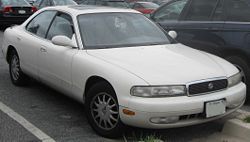- Mazda Sentia
-
Mazda Sentia 
Manufacturer Mazda Also called Amati 1000
Amati 1200
Ẽfini MS-9
Mazda Luce
Mazda 929 Serenia
Mazda 929
Mazda SentiaProduction 1991–1999 Predecessor Mazda Luce Class Luxury car Layout FR layout Platform HD, HE The Mazda Sentia is a large rear wheel drive luxury car sold in Japan in the 1990s. It replaced the Mazda Luce nameplate on the Mazda H platform cars for Japan in 1991 and was retired in 1999 after two generations.
1991
The Sentia has been developed with the future Mazda flagship, the Amati 1000 in mind. Anticipating that he Amati would take over the role of formal-use vehicles (i.e. chauffeur-driven transport for executives) in the product line, the first Sentia is considerably geared towards private owners in its focus. This is very evident in its Jaguar-inspired stance, relatively low roofline, as well as using more of its dimensions for styling as opposed to improving interior space.
The Sentia was marketed by Mazda as having a "front midship" layout: the V6 engine sits behind the front axle, while the fuel tank rests above the rear axle. This iteration of the Sentia also debuted Mazda's speed-sensitive four-wheel steering system. At speeds of lower than 35 km/h (22 mph), the rear wheels steer in an opposite (toe out) direction from the front wheels, in order to reduce the turn radius. At higher speeds they steer in the toe in direction to improve stability.
Solar ventilation system is a setup where amorphous solar cells in the sunroof panel powers small ventilation fans located in the trunk area, in order to cool the cabin while the car's parked in the sun. This setup would later be found on the Eunos800/Millenia.
There are two engines available. Both have their roots in prior Mazda V6s, and have no relation to the aluminum KL series found in the 626-platformed Mazdas. The 3-liter JE-ZE receives a new variable intake manifold to boost its power rating to 200 PS (147 kW; 197 hp). The 2.5-liter J5-DE is also available, rated at 160 PS (118 kW; 158 hp).
1995
The 1995 Sentia used Mazda's updated HE platform, and was the last large RWD sedan from Mazda.
The mechanical underpinnings are largely carried over from the previous Sentia. The exterior and interior received a mild redesign to make the car more stately, and suitable for formal corporate use. This includes a larger grille, taller roofline for improved rear headroom, as well as large expanses of woodgrain panelling. Some sources have said that the car incorporates a number of styling cues from the stillborn Amati 1000.
The advertising campaign featured Sean Connery saying the car is "...striking!".
Engines:
- 3.0 L JE-ZE V6
The second-generation Sentia drops the 2.5-liter engine, and uses the 3-liter unit in two different tuning for 200 PS (147 kW; 197 hp) and 160 PS (118 kW; 158 hp) respectively.
« previous — Mazda road car timeline, 1990s–present Type 1990s 2000s 2010s 0 1 2 3 4 5 6 7 8 9 0 1 2 3 4 5 6 7 8 9 0 1 Kei car Carol Carol Carol Carol Carol AZ-Wagon AZ-Wagon AZ-Wagon AZ-Wagon AZ-Offroad Spiano Scrum Scrum/Scrum Wagon Scrum/Scrum Wagon Subcompact Revue/121 Demio/121 Demio/Mazda2 Demio/Mazda2 Verisa Compact Familia/323/Protegé Familia/323/Protegé Familia/323/Protegé Axela/Mazda3 Axela/Mazda3 Familia Van Familia Van Familia Van Mid-size Capella/626 Capella Capella/626 Atenza/Mazda6 Atenza/Mazda6 Cronos/626/Xedos 6/Eunos 500 Eunos 800/Xedos 9/Millenia Mazda6 (N.America) Full-size Sentia/929/Efini MS-8 Sentia Sports car AZ-1 MX-3 Precidia Roadster/MX-5/Miata Roadster/MX-5/Miata Roadster/MX-5 MX-6/Mystère MX-6/Mystère/Efini MS-6 RX-7 Efini RX-7/RX-7 RX-8 Cosmo Minivan Premacy Premacy/Mazda5 Premacy/
Mazda5Bongo Friendee Biante Efini MPV/MPV MPV MPV/Mazda8 Crossover CX-7 CX-9 SUV Navajo Tribute Tribute Pickup B-Series B-Series B-Series BT-50 BT-50 Van Bongo Bongo Categories:- Mazda vehicles
- Luxury vehicles
- Rear wheel drive vehicles
- Vehicles with four wheel steering
- 1990s automobiles
Wikimedia Foundation. 2010.
